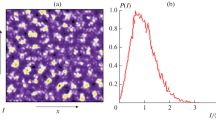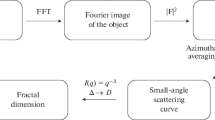Abstract
For many remote sensing applications it is beneficial to know how the amount of shadows on a surface depends on illumination. Many natural surfaces (planetary surfaces being an example) may be successfully described by a fractal model. While the fractal shadowing function can be easily calculated experimentally, to date no rigorous analytical model of self-shadowing on a fractal surface exists. In this paper we offer an integral form of the shadowing function for fractal surfaces with different fractal and roughness parameters. The analysis is based on working out the covariance matrix for an arbitrarily long sequence of heights in a fractal profile.
Similar content being viewed by others
References
T.W. Anderson, An Introduction to Multivariate Statistical Analysis. John Wiley&Sons, Inc., 1958.
B.B. Mandelbrot, The Fractal Geometry of nature. Freeman, New York, 1982.
B.A. Campbell and M.K. Shepard, “Shadows on a planetary surface and implications for photometric roughness,” ICARUS, Vol. 134, pp. 279–291, 1998.
R.F. Voss, “Fundamental algorithms for computer graphics,” in Proceedings of the NATO Advanced Study Institute on Fundamental Algorithms for Computer Graphics, R.A. Earnshaw (ed.). Springer-verlag, NATO ASI series, 1985, pp. 805–835.
Author information
Authors and Affiliations
Additional information
Svetlana Barsky received her BSc degree in Mathematics and Applied Mathematics from Novosibirsk State University, Russia, in 1992, and her MSc and PhD degrees from the University of Surrey, UK, in 1999 and 2003 respectively. Since then she has been working as a research fellow at the Centre for Vision, Speech and Signal Processing of the School of Electronics and Physical Sciecnes of Surrey University.
Maria Petrou studied Physics at the Aristotle University of Thessaloniki, Greece, Applied Mathematics in Cambridge and she did her PhD in the Institute of Astronomy in Cambridge, UK. She has been working on image processing and computer vision since 1986. She has been the Professor of Image Analysis since 1998 and leads a group of 20 researchers on this topic in Surrey University. She has published more than 250 scientific papers, on Astronomy, Remote Sensing, Computer Vision, Machine Learning, Colour analysis, Industrial Inspection, Medical Signal and Image Processing. She has co-authored a book “Image Processing: the fundamentals” published by John Wiley in 1999 and reprinted in 2000 and 2003, and numerous book chapters. She is a Fellow of the Royal Academy of Engineering, Fellow of IEE and Fellow of IAPR. She has served as the Chairman of the Technical Committee for Remote Sensing of IAPR, the Chairman of the British Machine Vision Association (BMVA), as an Associate Editor of IEEE Transactions on Image Processing, as the Newsletter Editor of IAPR and is currently the treasurer of IAPR and an Honorary Editor of IEE Electronics Letters. A full list of publications and other details can be found in http://www.ee.surrey.ac.uk/Personal/M.Petrou
Rights and permissions
About this article
Cite this article
Barsky, S., Petrou, M. The Shadow Function for Rough Surfaces. J Math Imaging Vis 23, 281–295 (2005). https://doi.org/10.1007/s10851-005-0484-6
Issue Date:
DOI: https://doi.org/10.1007/s10851-005-0484-6




